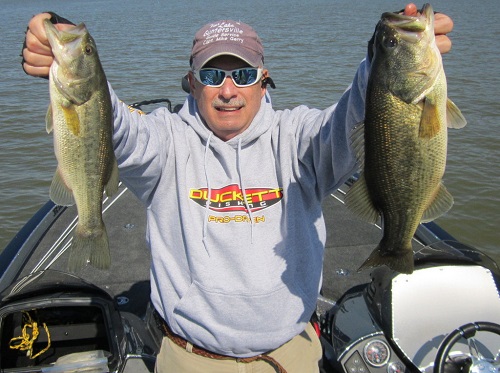 With the spawn approaching bass will start to migrate toward the spawning grounds; they will use any and every piece of cover on their way to the spawn to stop and look for food. Knowing this, allows me to look for cover that sits outside the flats or near the spawning grounds; generally 200 to 400 yards is a good distance for this to occur. So to be efficient this time of year I find the cover whether it be, visible or not and use it to find the bass that are working their way to the spawn.
With the spawn approaching bass will start to migrate toward the spawning grounds; they will use any and every piece of cover on their way to the spawn to stop and look for food. Knowing this, allows me to look for cover that sits outside the flats or near the spawning grounds; generally 200 to 400 yards is a good distance for this to occur. So to be efficient this time of year I find the cover whether it be, visible or not and use it to find the bass that are working their way to the spawn.

Migration paths are generally creeks next to flats or road beds even ditches that might work toward the backs of the creeks or open bays. These migration paths become highways and there is no pattern that you can count on more this time of year than these pathways. They are real; they hold fish and you will be surprised how they replenish even when you’re catching fish. The fact is if you go back to the B.A.S.S. Classic that Kevin Van Dam won on Lay Lake in Birmingham Al. you will see that a single stump field in a small narrow creek held fish for several days and replenished continually over the day during the spawn migration. Allowing him to basically sit on one spot and catch fish for the complete tournament.
The key factor was the creek had a ditch that flowed into a small stump field just outside a bridge where bait gathered and bass moved in and out feeding and using the ditch to continually replenish and ambush bait around the stumps. Van Dam basically found these fish and proved in the practice that they would replenish so he sat on this area for most of the tournament; bringing in a big winning stringer to when the 2010 Classic with 51 lbs. 6 oz. over the event!
Transition fishing was the key and it can be the same key to your success this time of year!
Fish Lake Guntersville Guide Service
www.fishlakeguntersvilleguideservice.com
www.facebook.com/FishGuntersville
Email; bassguide@comcast.net
Call: 256 759 2270
Capt. Mike Gerry
